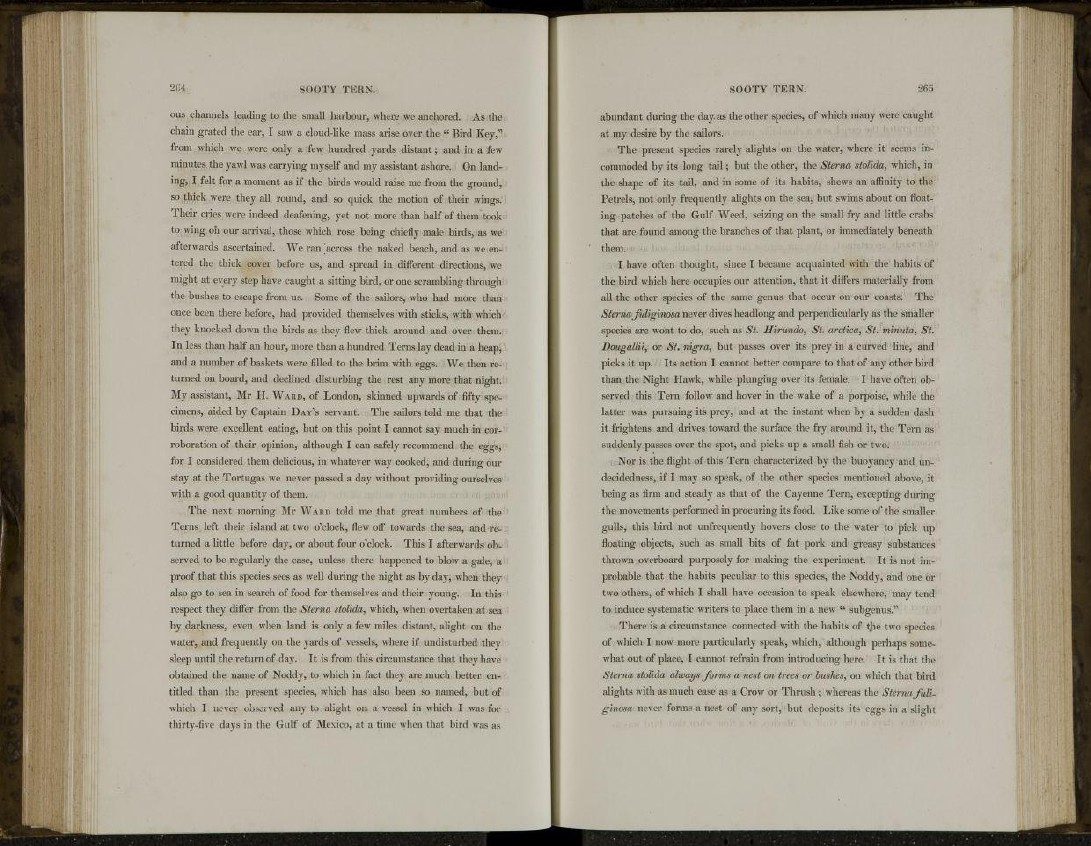
SOOTY TERN.
ous channels leading to the small harbour, where we anchored. As the
chain grated the ear, I saw a cloud-like mass arise over the " Bird Key,"
from which we were only a few hundred yards distant; and in a few
minutes the yawl was carrying myself and my assistant ashore. On landing,
I felt for a moment as if the birds would raise me from the ground,
so thick were they all round, and so quick the motion of their wings.
Their cries were indeed deafening, yet not more than half of them took
to wing oh our arrival, those which rose being chiefly male birds, as we
afterwards ascertained. We ran ^across the naked beach, and as we entered
the thick cover before us, and spread in different directions, we
might at every step have caught a sitting bird, or one scrambling through
the bushes to escape from us. Some of the sailors, who had more than
once been there before, had provided themselves with sticks, with which
they knocked down the birds as they flew thick around and over them.
In less than half an hour, more than a hundred Terns lay dead in a heap,
and a number of baskets were filled to the brim with eggs. We then returned
on board, and declined disturbing the rest any more that night.
My assistant, Mr H. WARD, of London, skinned upwards of fifty specimens,
aided by Captain DAY'S servant. The sailors told me that the
birds were excellent eating, but on this point I cannot say much in corroboration
of their opinion, although I can safely recommend the eggs,
for I considered them delicious, in whatever way cooked, and during our
stay at the Tortugas we never passed a day without providing ourselves
with a good quantity of them.
The next morning Mr WARD told me that great numbers of the
Terns left their island at two o'clock, flew off towards the sea, and returned
a little before day, or about four o'clock. This I afterwards observed
to be regularly the case, unless there happened to blow a gale, a
proof that this species sees as well during the night as by day, when they
also go to sea in search of food for themselves and their young. In this
respect they differ from the Sterna stolida, which, when overtaken at sea
by darkness, even when land is only a few miles distant, alight on the
water, and frequently on the yards of vessels, where if undisturbed they
sleep until the return of day. It is from this circumstance that they have
obtained the name of Noddy, to which in fact they are much better entitled
than the present species, which has also been so named, but of
which I never observed any to alight on a vessel in which I was for
thirty-five days in the Gulf of Mexico, at a time when that bird was as
SOOTY TERN. 2fJ5
abundant during the day. as the other species, of which many were caught
at my desire by the sailors.
The present species rarely alights on the water, where it seems incommoded
by its long tail; but the other, the Sterna stolida, which, in
the shape of its tail, and in some of its habits, shews an affinity to the
Petrels, not only frequently alights on the sea, but swims about on floating
patches of the Gulf Weed, seizing on the small fry and little crabs
that are found among the branches of that plant, or immediately beneath
them.
I have often thought, since I became acquainted with the habits of
the bird which here occupies our attention, that it differs materially from
all the other species of the same genus that occur on our coasts. The
Sterna fuliginosa never dives headlong and perpendicularly as the smaller
species are wont to do, such as St. Hirundo, St. árctica, St. minuta, St.
Dougallii, or St. nigra, but passes over its prey in a curved line, and
picks it up. Its action I cannot better compare to that of any other bird
than the Night Hawk, while plunging over its female. I have often observed
this Tern follow and hover in the wake of a porpoise, while the
latter was pursuing its prey, and at the instant when by a sudden dash
it frightens and drives toward the surface the fry around it, the Tern as
suddenly passes over the spot, and picks up a small fish or two.
Nor is the flight of this Tern characterized by the buoyancy and undecidedness,
if I may so speak, of the other species mentioned above, it
being as firm and steady as that of the Cayenne Tern, excepting during
the movements performed in procuring its food. Like some of the smaller
gulls, this bird not unfrequently hovers close to the water to pick up
floating objects, such as small bits of fat pork and greasy substances
thrown overboard purposely for making the experiment. It is not improbable
that the habits peculiar to this species, the Noddy, and one or
two others, of which I shall have occasion to speak elsewhere, may tend
to induce systematic writers to place them in a new " subgenus."
There is a circumstance connected with the habits of tjie two species
of which I now more particularly speak, which, although perhaps somewhat
out of place, I cannot refrain from introducing here. It is that the
Sterna stolida always forms a nest on trees or bushes, on which that bird
alights with as much ease as a Crow or Thrush ; whereas the Sterna fuliginosa
never forms a nest of any sort, but deposits its eggs in a slight